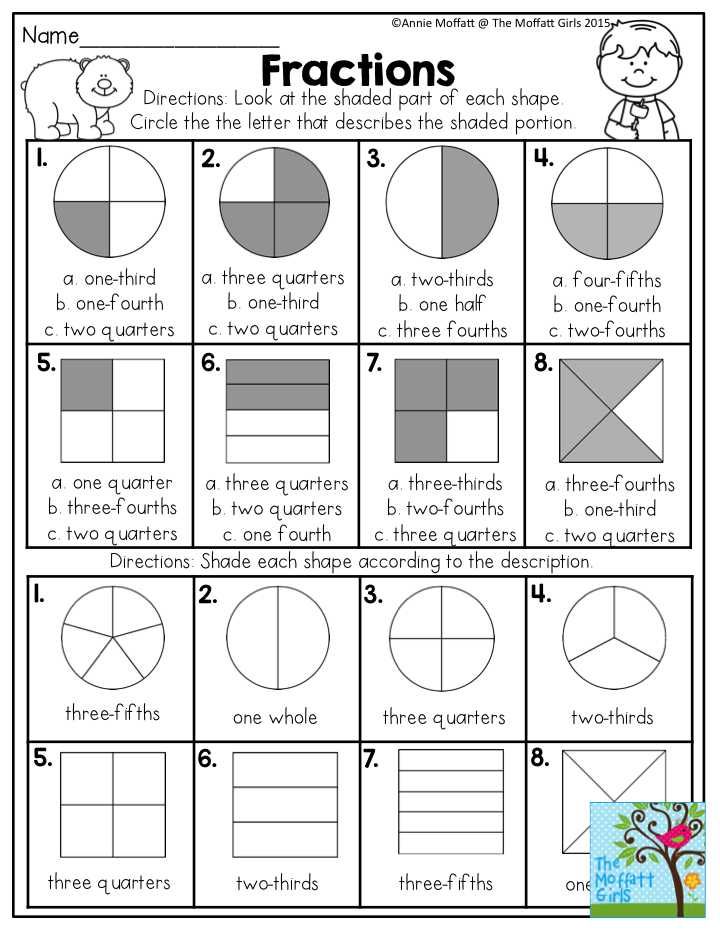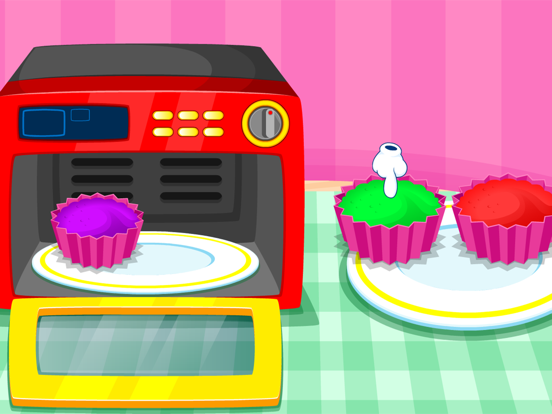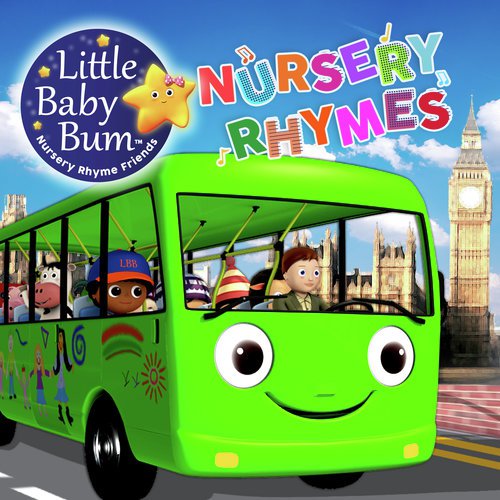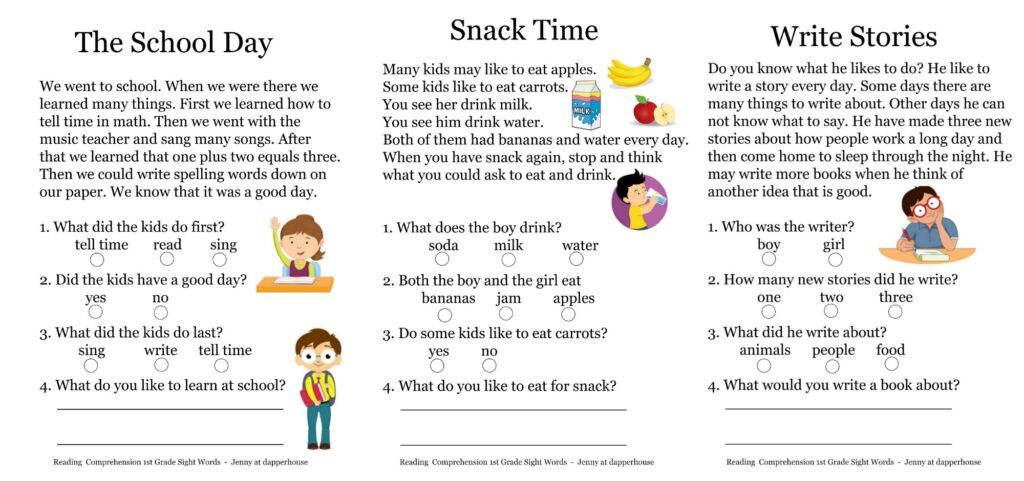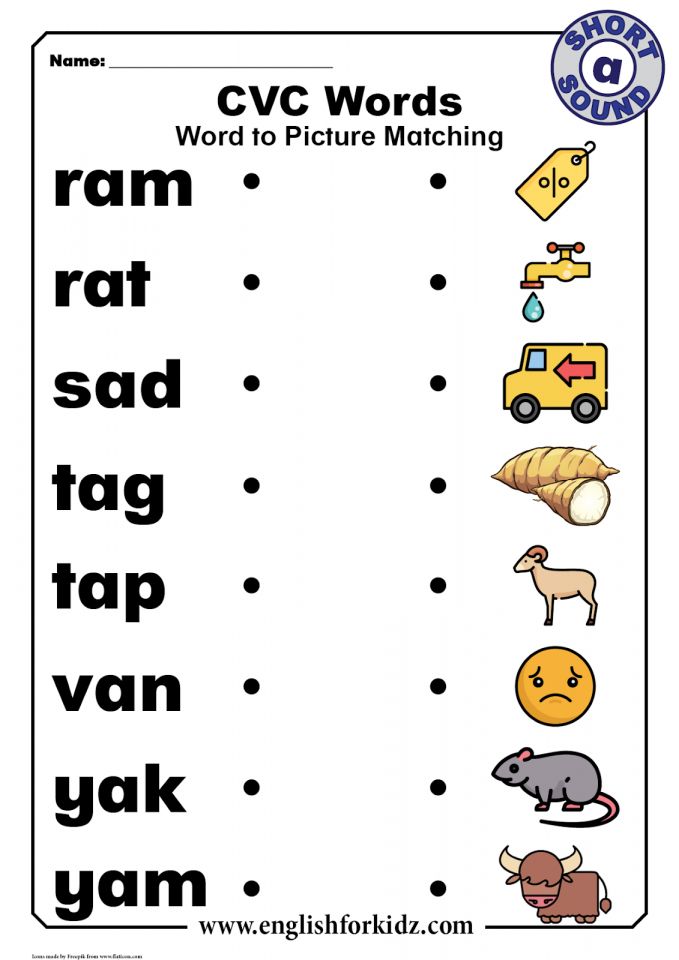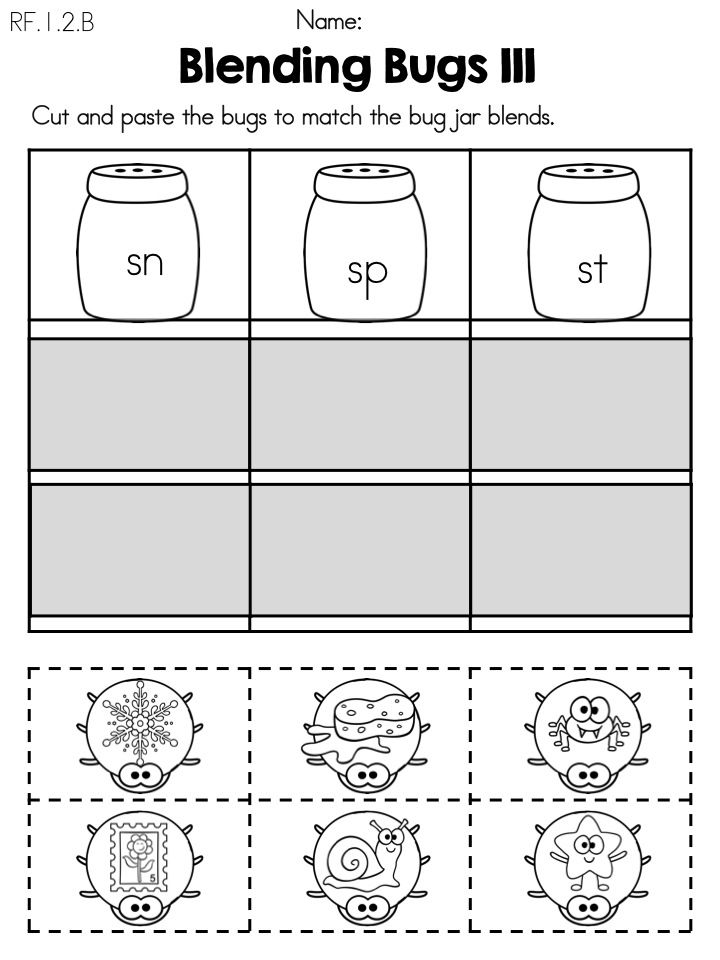Teaching first grade fractions
Miss Giraffe's Class: Fractions in First Grade
I know I seem to say this about every math concept I blog about but I LOVE FRACTIONS.
Well, the first grade version of fractions :)
It's weird to even hear myself say it because I struggled, and I mean struggled, with fractions in school. I was a good test taker though so I always flew under the radar with my teachers but I remember just looking at them like What is this?!
SO I think it is really important to build those fraction foundations so your students don't end up staring at fractions the way I did!
I think the first concept in fractions to teach is EQUAL PARTS, or EQUAL SHARES.
See those funky shapes with unequal parts on the right?? We call those "nutty shapes"!
Our job is to help our squirrel friend find the nutty shapes with unequal parts so we sorted the shapes by whether they had equal parts or unequal parts.
Then some practice!
Once your students understand that fractions have equal parts, I recommend having them partition fractions themselves! The most fun way to do this, in my opinion, is with dough!
In small groups, give each student a ball of dough. Provide a rolling pin for them to roll their balls flat and some circle cookie cutters to cut out circles. If you don't have rolling pins, you can use pretty much anything - even a highlighter - or they can just smash it down with their hands. If you don't have circle cookie cutters, you can use anything with a circle base. Turn a plastic cup upside down and press it in. Can you tell I improvise a lot?? :)
This activity is not only super fun but it promotes SO much good conversation and thinking.
Guide your students by having them cut one of their circles in half. Talk about how each of the 2 shares is a half and together they're called halves. Then have them cut their other circle into half.. and then half again. Let them know these are called fourths because there are four equal parts. As they're looking at their halves and fourths side by side, ask them if they notice anything. Discuss how the more shares you cut it into, the smaller the shares get. You could also cut your circle in an unequal way and ask if it's cut into halves/fourths/whatever and help them see that the shares must be equal to be called halves/fourths/etc.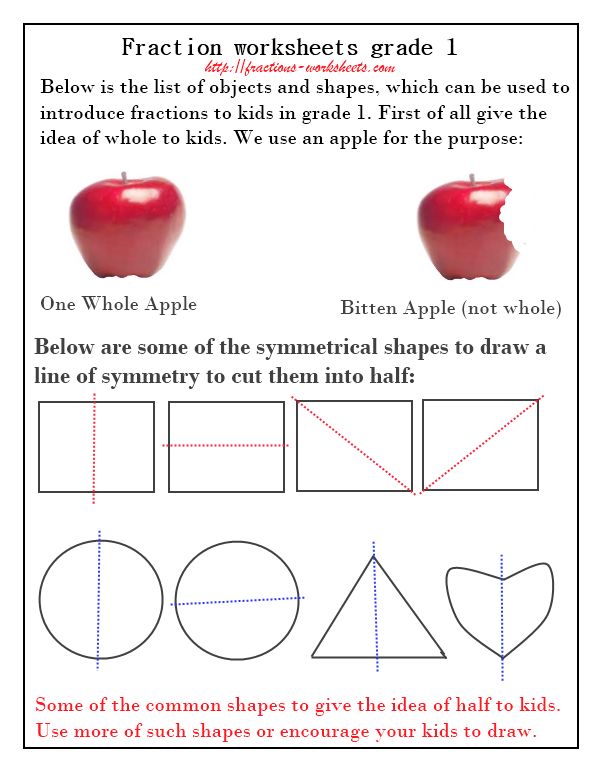 There are so many great concepts you can teach with the dough out! I also made a cute little recording sheet to go along with it so they can write about what they learned during/after their exploration.
There are so many great concepts you can teach with the dough out! I also made a cute little recording sheet to go along with it so they can write about what they learned during/after their exploration.
For more halves, fourths, etc. practice, I made practice sheets in different difficulty levels.
One of the types of worksheets I made were these sheets that focus on a specific type of fraction (cut into halves, thirds, fourths, or eighths).
I love these because they practice several skills at once but for each type of fraction so it's not too confusing or overwhelming.
If you need something a little easier, this is a great worksheet to do first to review what halves, thirds, and fourths are:
And of course some cutting and pasting action because I love having them for every math concept ever because kids love it and it is great, self-checking practice.
I've said this before but...
According to 5 and 6 years olds:
Math Worksheet = Math.
Math Worksheet + Cutting/Gluing = Party.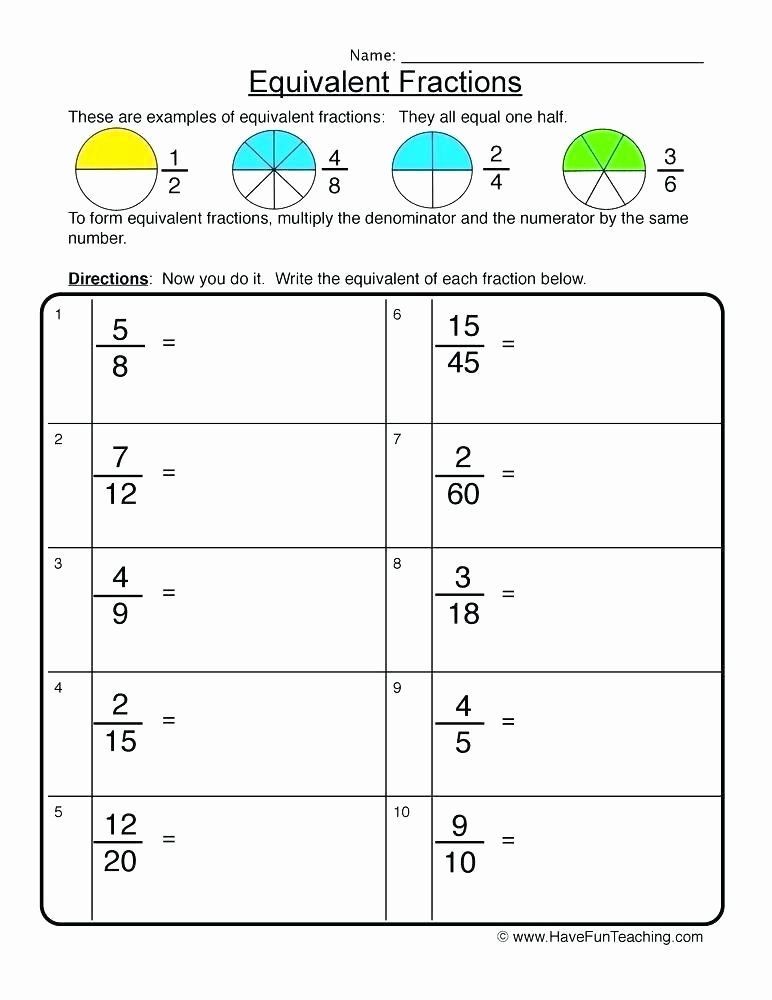
:)
and a little coloring action too because who doesn't love coloring?!
Once you think they've got it down, I recommend busting out the Fraction Flowers!!
I included this activity in a bunch of different ways because I love it so much. You can use it as a craft, a math puzzle/center, or hang the flowers up as a poster or visual aid.
The craft makes a super duper cute bulletin board!
I love the way ours turned out! Sorry for the #notsohumblebrag but I can't help it - I love, love them and they were a lot of fun to make!
Can someone help me think of a cute bulletin board title? "Come see what we're growing in our Fraction Garden!" "Our Fraction Garden is Blooming" ... I can't figure out exactly what I want it to say :)
For this math craft, we sorted the HALF OF fractions and FOURTH OF fractions. I also include WHOLE, THIRD OF, and EIGHTH OF.
It's differentiated as well so you can choose how much to challenge your students. Each flower comes in both full color and black & white.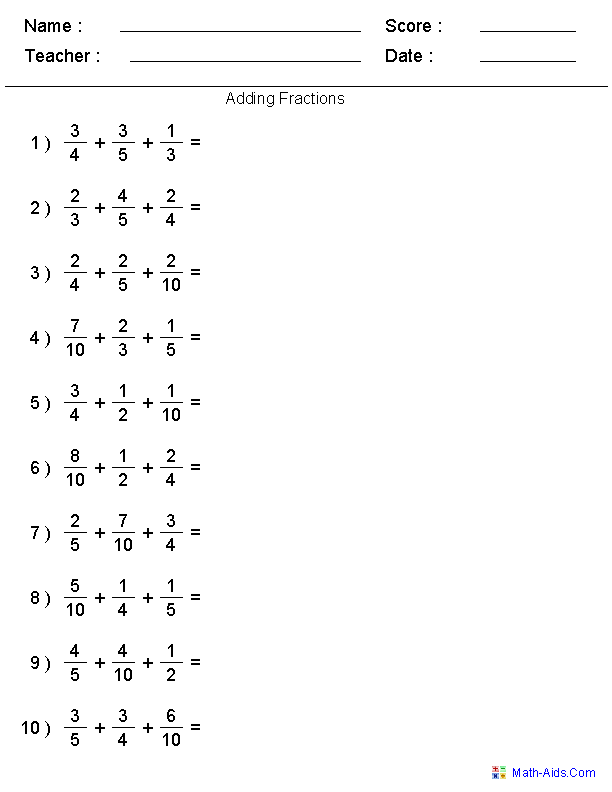 Each of those options also comes in pre-made (where the flower is already put together as a pretty flower like you see above) OR mixed up in pieces for students to sort and build their own flowers.
Each of those options also comes in pre-made (where the flower is already put together as a pretty flower like you see above) OR mixed up in pieces for students to sort and build their own flowers.
For the craft, I just printed the premade black and white flowers so all you had to do is color in the fraction either half of or fourth of, color the rest of your flower, and then cut and glue it to the construction paper.
What I recommend if your students are up for the challenge (or you have a select few that are) and you have the time, have them sort the petals to the right flower first! It's an awesome sorting activity that adds even more learning to the craft. Print the 'mixed up in pieces' black and white version for students to SORT FIRST to build their flowers. They'll put the petals with the right flowers and arrange them to build their flowers. It might not be as "perfect" looking for your bulletin board as the above example but it'll be authentic and awesome! (I used to always want bulletin boards to be perfect examples of perfect work and I finally realized that was silly and it was the imperfections and differences that made them authentic and beautiful examples of work - random weird philosophical thought, sorry! :))
The mixed up pieces color version is a review center for next week!
Students sort the petals to the right fraction and then copy what they match onto their recording sheet.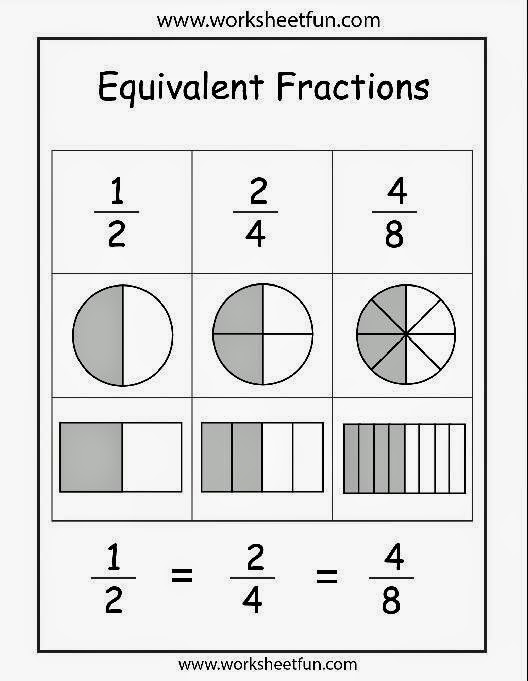
For the premade color ones, I printed and laminated them to use as a visual.
Right now, they're on my table as a reference tool but I'm going to cut them out and hang them up as a classroom poster display soon.
Being able to partition the fractions into halves and fourths themselves is a big concept in first grade so that's important to practice! I made worksheets to practice but this one (the easy level - A) is good to throw in a pocket protector with dry erase markers to practice in small groups when introducing it. Encourage your kiddos to find multiple ways to divide the circle/square into halves/fourths/thirds/whatever.
Once you feel like they really get the fundamental concepts, you can move into the number representation of fractions. I know a lot of first grade teachers are told not to do it but I personally think that once you lay down the basics, they're very capable. If you're saying "1 out of 3" shares, they might as well know the representation.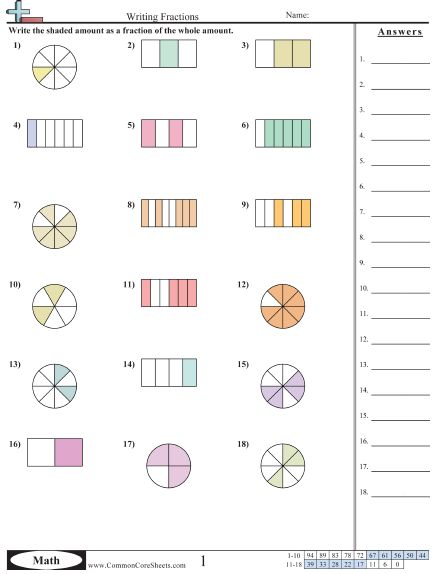 BUT if you disagree, that's fine! I created some very simple straightforward worksheets and centers to practice it for those who want to venture into the fraction abyss.
BUT if you disagree, that's fine! I created some very simple straightforward worksheets and centers to practice it for those who want to venture into the fraction abyss.
I think a great way to help kids understand it is to write "out of" on the line that separates the numerator and denominator and teach them to read down to "read" the fraction. It really helps them get what the fraction means, but most importantly, they won't mix up the numerator and denominator if they know what the written expression for the fraction actually means. For example, the circle has 3 out of 4 pieces colored so that is how they would read it starting at the 3 and going down: "3 out of 4". Here is what I mean:
Puzzles obviously because I would make puzzles of puzzles if I could :)
And what else?? Cut and pasting fun! Always <3
Thank you for listening to me share some of my ideas for teaching fractions. I hope you got some new ideas!
If you want the activities from this post, they're ALL included in my:
First Grade Math Unit 18
along with A LOT more worksheets, centers, cutting and pasting activities, and assessments!
Unit 18 is also included in the First Grade Math Units 10-18 Bundle if you want all of the second half of my first grade math units :)
Okay one more thing I want to share with you that I love.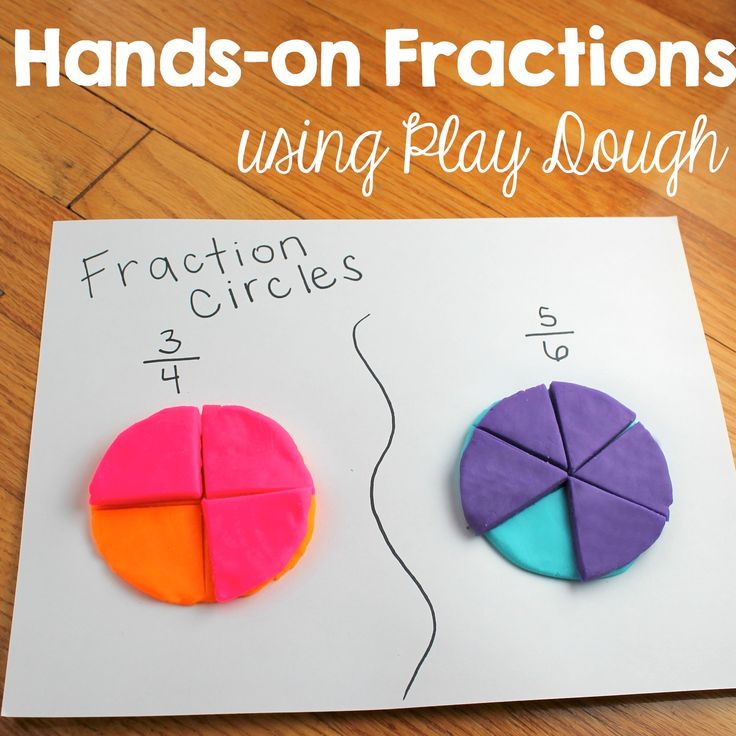 ....
....
FRACTION BOWLING!!!
I scored this adorable little bowling set at Target for only $7 over the weekend and I'm so excited to use it. You can find 10-piece bowling sets in a lot of places so if you can't find this at Target, I'm sure you can find one online pretty easily. It comes with 10 plastic bowling pins and 2 little plastic balls.
So the way to play Fraction Bowling is to set up all the pins. (It comes with a mat that shows exactly where to set the pins to make it easy for kids to set up but I set it up without it because it's cuter for the picture, not gonna lie :))
Have students take turns rolling the ball to the pins to try and knock them down. I recommend letting them roll it twice just like with regular bowling so they don't completely miss on their turn and get upset. There are 2 balls.. an orange ball and a purple ball so they could get both balls to start and roll each.
At the end of their turn, they go to their recording sheet and color in how many pins they knocked down out of the 10 pins on the worksheet.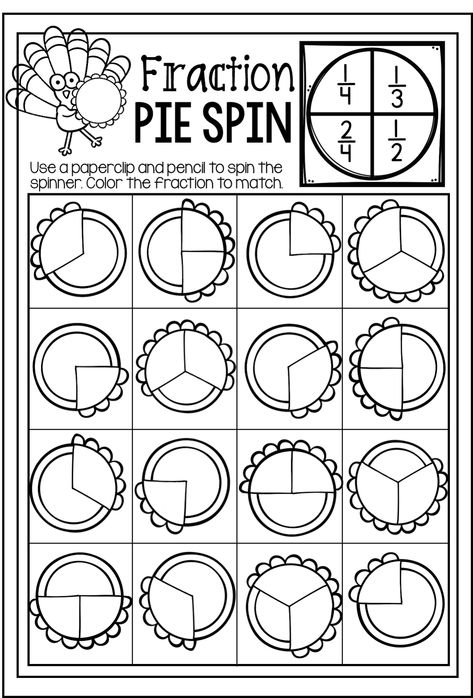 Then, they write the fraction they made. So if they knocked down 4 pins, they'd color in 4 of the pins on their recording sheet and write 4/10 next to it. You can skip the writing the fraction part if your kids aren't ready for it. Just the 4 out of 10 is great practice anyway! Or if you want to make it harder for your super high kids, make them make a fraction of ALL the pins once they're all done (ex: 36/60 pins total).
Then, they write the fraction they made. So if they knocked down 4 pins, they'd color in 4 of the pins on their recording sheet and write 4/10 next to it. You can skip the writing the fraction part if your kids aren't ready for it. Just the 4 out of 10 is great practice anyway! Or if you want to make it harder for your super high kids, make them make a fraction of ALL the pins once they're all done (ex: 36/60 pins total).
I made a simple little recording sheet to go with it that you can download for free by clicking here:
Fractions Bowling
:)
If you want to save these ideas for later on Pinterest, feel free to pin this or any other picture from this post:
Fractions for First Graders - Firstgraderoundup
We've been tackling ~FRACTIONS~ the last two weeks in first grade! I used to dread teaching fractions to 6 year old littles, but thanks to some extra CGI training on fractions...I love it!
The biggest ah-ha I've learned over the years is that fractions and shapes go together.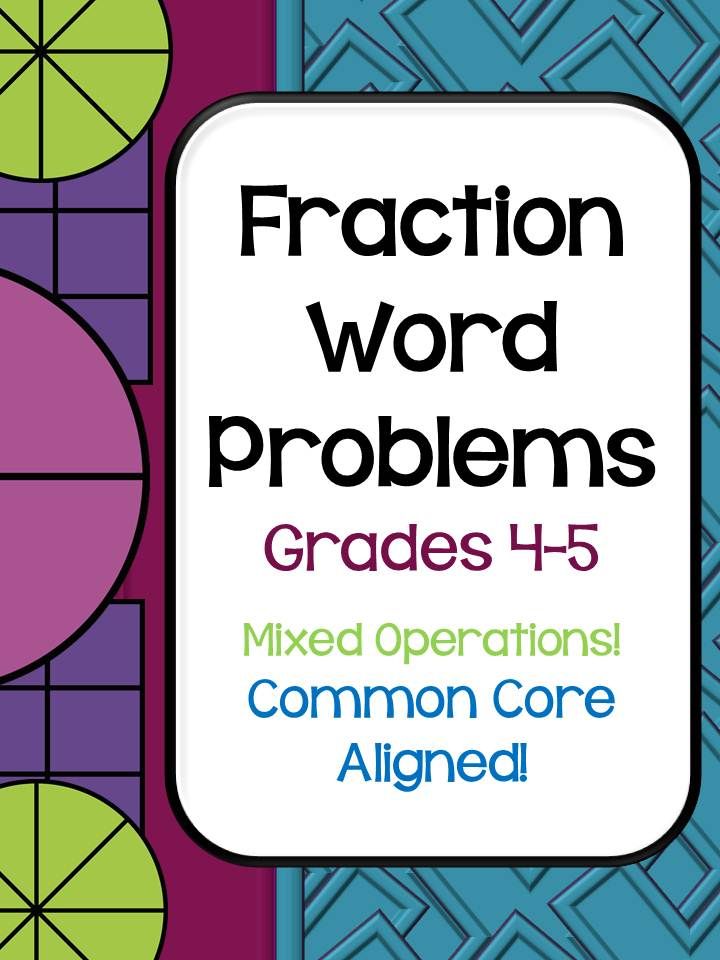 They are all under the umbrella of "geometry." Having math talks about shapes bleeds over into conversations about fractions and vice versa!
They are all under the umbrella of "geometry." Having math talks about shapes bleeds over into conversations about fractions and vice versa!
We spent the first week talking about the difference between "whole" and "half."
The first day, I posed a CGI problem...
"Mrs. Shaddock has 1 cookie to give to 2 first graders. How much cookie can each friend have to get a fair share?"
I love starting with this problem because it sets kids up for a problem....what are they going to call that part of the cookie? In my experience, most firsties can tell, show or act out the fact that it's a half of a cookie...but not as many know how to label it. I got a wide variety of answers once again this year...
*1
*1 piece
*1 cookie
*2 cookies
*half
We shared many of these and talked about the fact that if I just say "1" or "1 piece" I don't know how much that is. When I just say "1" I'm assuming a whole cookie...If I told you I would give you one cookie, but I only gave you one small piece, you would be upset because you assumed I would give you the WHOLE cookie!
Then, we start our whole/part anchor chart.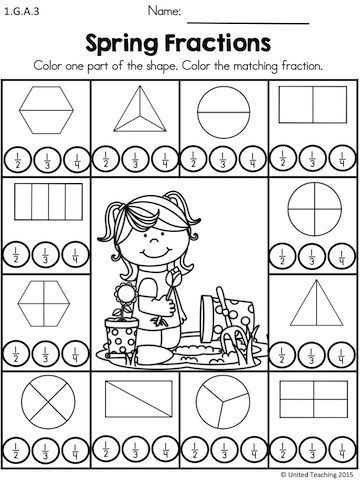 ..
..
Of course, we didn't add the fourths until the second week. Also, notice the emphasis on this anchor chart on "whole" and "part." We worked on fraction CGI problems these weeks, but also some part part whole CGI problems and we were able to make some really great connections between these problems and fractions during our share time that made fractions easier to understand!
The next day, we did a few math talks about which shapes were divided in half using the math talk slides from my geometry packet...Then, the next morning, the kids did this sort for morning work (halves/not halves the first week and fourths/not fourths the next week)....
On the last "math skill" day of the week, we played "Pass the Pen," which happens to be the simplest game and one of my first graders' favorites....
Get this:
*Share the paper between your table group and choose a "pen" (or pencil or crayon) to share between your table group.
*One person starts and divides a shape in half/fourth.
*Then, they....wait for it...pass the pen...to the next person at the table who has to divide another shape in half/fourths a different or new way.
*They keep passing the pen until they cannot think of any more new ways.
It's definitely not rocket science, but they love it! And this game is so good to use in pretty much any subject area!
If a kid doesn't know what to do, they other friends at the table can help him/her and tell her what to do, but can't do it for him....
We did one round of the squares and then shared pictures and talked about if they were halves/fourths and why or why not. We talked a lot about being precise and how that affects the partitioning. And for whatever reason, squiggly lines were quite popular this year, so we had to talk about that too!
Once we discussed the squares they flipped their paper to the other side and played the same game with circles.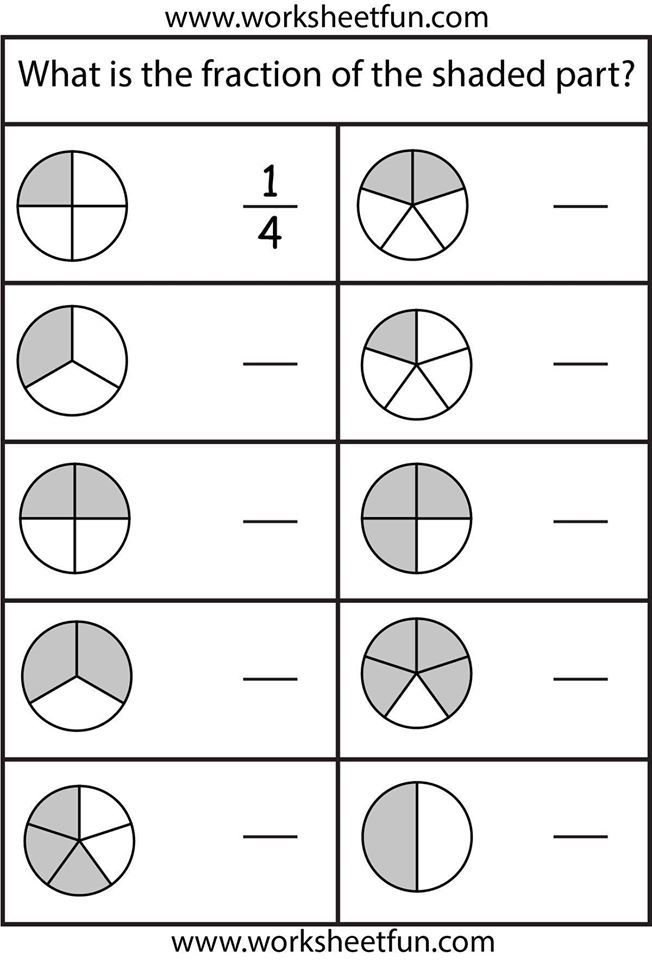
At the end of the activity, I had them pass the pen to assess the squares together and then self-assess the circles as a group. Love these smiley face grades! :)
Fractions came after all of our 2D and 3D shape exploration in geometry, and our next step will be symmetry...but that will probably be after Christmas break! We are about to be in full on assessment mode in my world! #keepinitreal
Grab these activities and more in my complete geometry packet!
Fractions - how to explain actions with fractions to a child
The topic of fractions is one of the most difficult for schoolchildren. To understand them for an unprepared child, and even more so to perform operations with them, can be quite difficult. But even the most difficult task can become simple and understandable if approached correctly. For children, you need to use fantasy, visualization and elements of the game. And also to remain calm and patiently explain, even if it needs to be done many times.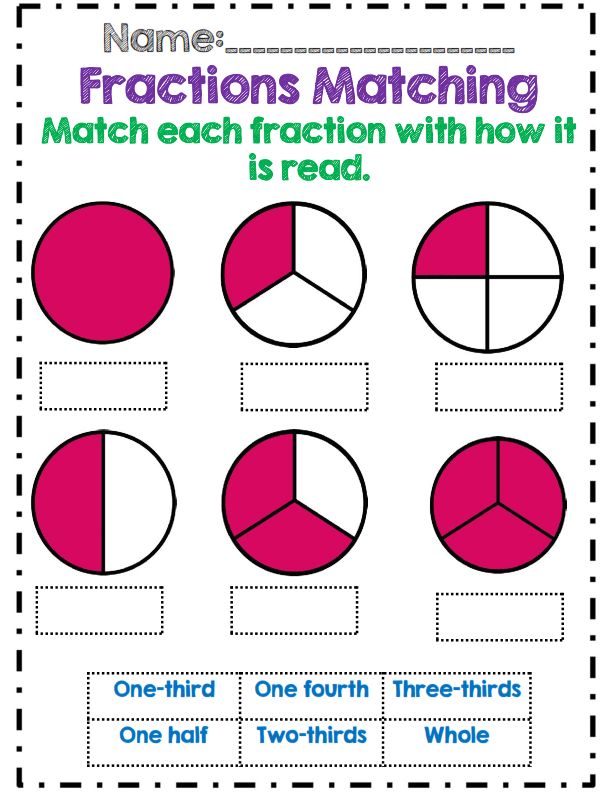
How to explain the essence of fractions to a child?
The word "fraction" seems to speak for itself - it means crushing, division. In the school curriculum, the study of fractions begins only in the 5th grade, having mastered all the actions with integers. But it is advisable to start acquaintance with them in advance, even at the senior preschool age. This forms spatial representations in children and trains logical thinking.
First you need to explain the concept of shares to the child. This is very easy to do with illustrative everyday examples. The simplest and most affordable is food. For example, a pie is a whole. It can be divided into several identical parts. One piece of such a pie will be called one share of all possible. Dividing the cake into four parts, one piece is called one fourth.
Anything can be divided this way: apples, oranges, chocolate bars, candies in a box, etc. Another great visual material for learning fractions is Lego bricks.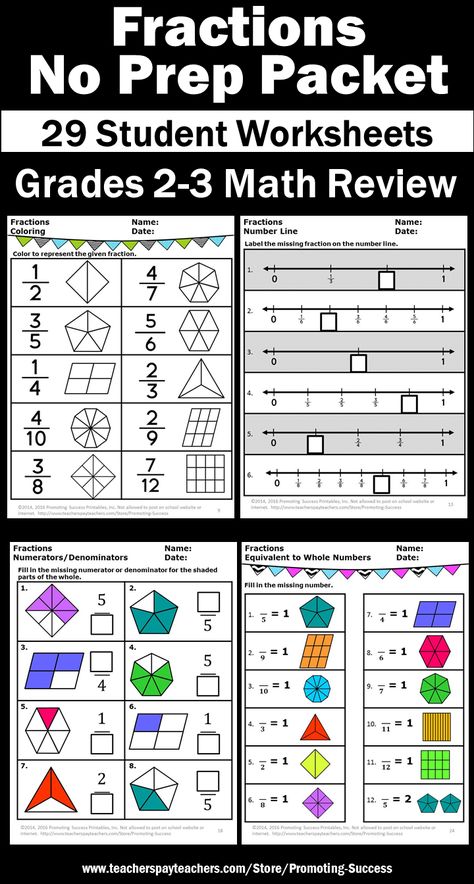 With their help, you can divide the whole into equal parts very easily. Children quickly memorize the shape of the cubes, and they do not need to constantly recalculate the number of protruding elements on them.
With their help, you can divide the whole into equal parts very easily. Children quickly memorize the shape of the cubes, and they do not need to constantly recalculate the number of protruding elements on them.
If a child sees the practical use of fractions and their demand in real life, it will be easier for him to understand them and realize the importance of obtaining mathematical knowledge and skills.
What do you need to know about fractions?
1. A fraction is a non-integer number, it denotes the number of parts of a whole.
2. A fraction is less than a whole.
3. The more parts the whole is divided into, the smaller these parts are, and vice versa - the fewer parts, the larger they are, respectively.
To denote shares in mathematics, the concept of an ordinary fraction is used. With its help, you can record absolutely any number of shares you need.
An ordinary fraction consists of two parts, called the numerator and denominator.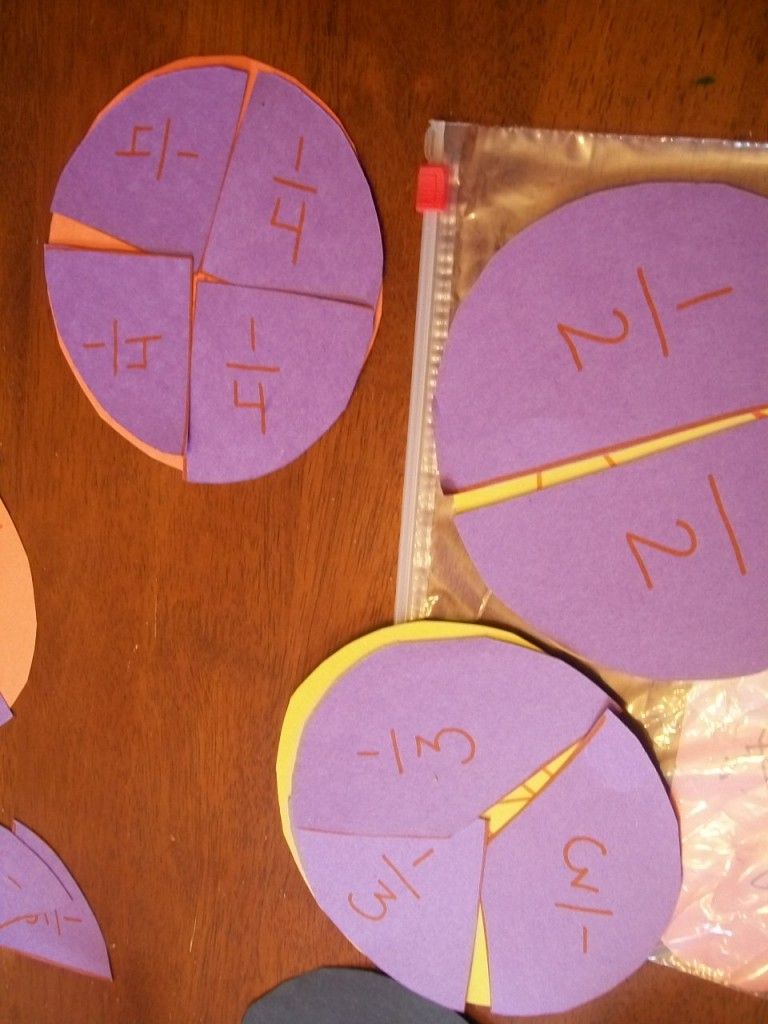 They are written separated by a horizontal line or a line slanted to the right. The denominator is written below or to the right of the fractional bar, it shows the total number of parts from the whole by which it was divided. And the numerator is written at the top or to the left of the fractional line and shows how many parts of the whole have now been taken.
They are written separated by a horizontal line or a line slanted to the right. The denominator is written below or to the right of the fractional bar, it shows the total number of parts from the whole by which it was divided. And the numerator is written at the top or to the left of the fractional line and shows how many parts of the whole have now been taken.
Let's get back to our pie. It is obvious that it is realistic to divide it into any number of equal parts. Depending on how many parts it is divided into, the denominator of the fraction also changes. For a pie divided by one straight line into two parts, the denominator will be 2, for a pie divided into three parts - 3, etc. The numerator, in turn, shows how many parts are now taken. If you take only one part out of two, then you get a fraction 1/2, only two out of three - 2/3, etc.
What are mixed fractions?
In mathematics, correct and improper fractions are distinguished. Correct - those whose numerator is less than the denominator.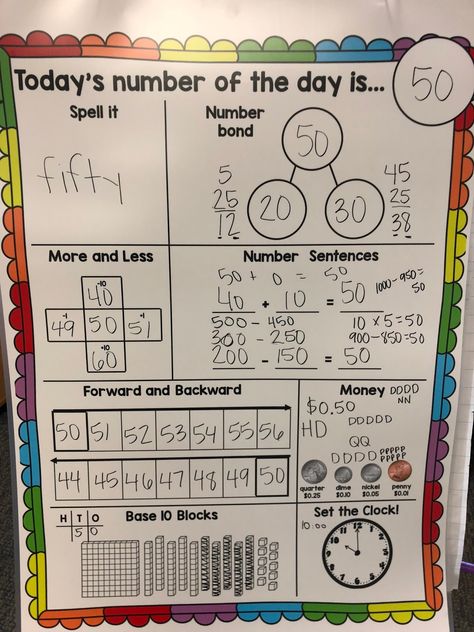 For example: 1/3 , 2/5 , 4/12 . But it also happens that the numerator becomes larger than the denominator. If you explain in detail, then more parts of the pie were taken than there were those into which it was divided. This is quite possible in life and in mathematics.
For example: 1/3 , 2/5 , 4/12 . But it also happens that the numerator becomes larger than the denominator. If you explain in detail, then more parts of the pie were taken than there were those into which it was divided. This is quite possible in life and in mathematics.
In such fractions, you can separate the whole part and the remaining fraction after that. That is, it will be seen how many whole pies are taken and plus a certain number of its parts. You need to imagine well what is described, or even check it in practice, and not just memorize the formulas. Then the reduction of fractions will be performed by the child meaningfully and accurately.
To convert an improper fraction to a mixed number, first divide the numerator by the denominator. As a result, we almost always get an integer and some kind of remainder. An integer and must be written as an integer part. And the remainder is sent to the numerator of the fractional part.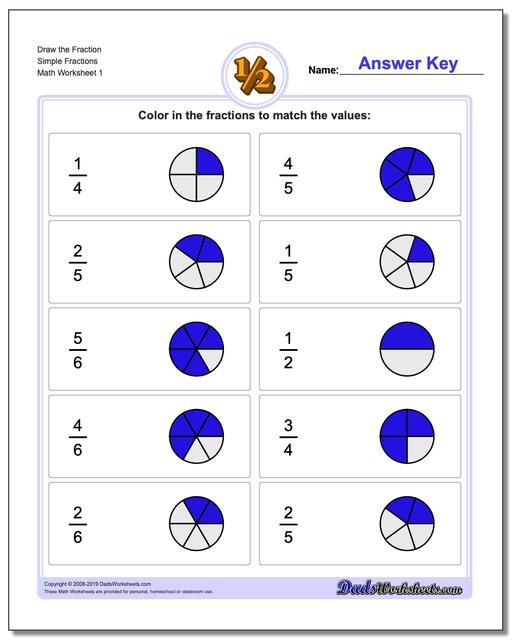 Only the denominator remains unchanged.
Only the denominator remains unchanged.
Fractions with the same number above and below the fractional bar are also called incorrect: 6/6 , 12/12 , etc. Obviously, they can be turned into 1. Visually, this is taken as many pieces of the pie as it is and was divided, that is, the whole pie.
Examples:
- 14/5 = (5*2+4) / 5 = 2 4/5
- 21/6 = (6*3+ 3) / 6 = 3 3/6
Task:
Find the whole part of improper fractions:
- 15/4,
- 22/12,
- 30/7.
You can do the opposite procedure - turn a mixed number into an improper fraction. This operation is often used in mathematical calculations, so it will be useful to learn about it. To do this, you must first multiply the integer part and the denominator. Then add the resulting number to the numerator, and leave the denominator the same.
Examples:
- 3 1/8 = (3*8+1) / 8 = 25/8
- 7 4/9 = (7*9+4) / 9 = 67/9
Job:
1.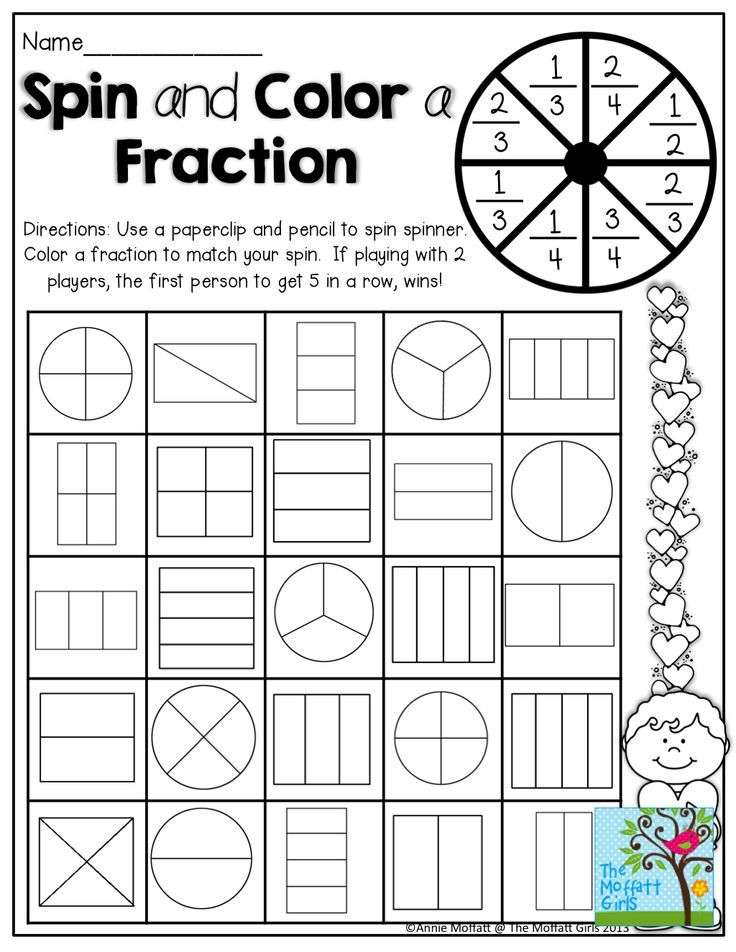 Convert improper fraction to mixed number:
Convert improper fraction to mixed number:
- 27/4,
- 18/5,
- 45/7.
2. Perform the inverse of the first task - turn the mixed number into an improper fraction:
- 3 4/5;
- 12 7/11.
Decimals
Fractions whose denominators contain numbers that are multiples of ten - 10, 100, 1000, etc. - in mathematics can be denoted as follows. The integer part is written first, and then the numerator from the fractional part, separated by a comma.
For example, let's try to write 5 4/10 as a decimal fraction. We write the integer part (5), put a comma and then write the numerator of the fractional part (4). We get: 5.4 . This fraction is read like this: "five whole and four tenths." A number represented in this form is called a decimal.
There are also decimals without an integer part. For example: 7/100 . How to be in that case? To write down a similar fraction, write zero, put a comma and then write down the numerator of the fraction - 0.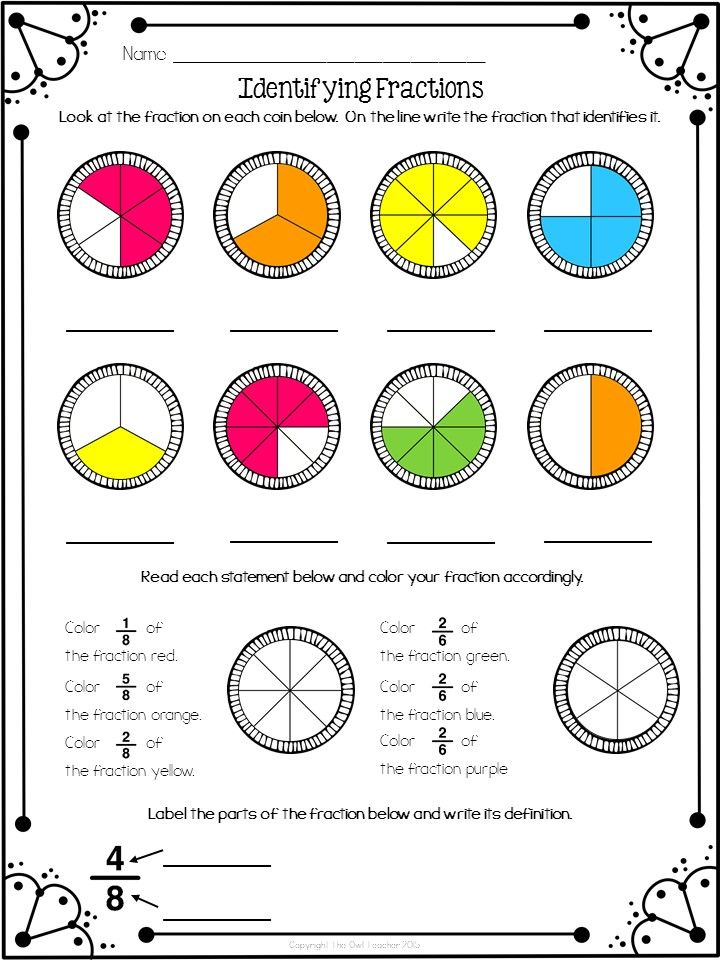 07 . Such a fraction is read as "zero point, seven hundredths."
07 . Such a fraction is read as "zero point, seven hundredths."
Decimals are very handy, they are used in exact calculations. The decimal system has been used by mankind since ancient times. It is intuitive and simple.
Reference:
Convert the following fractions to decimals:
- 8/10,
- 4/100,
- 7/1000.
Reduction of fractions
Reduction of fractions is performed in order to simplify them. If the numerator and denominator of a fraction are such that they are divisible by the same number (have a common divisor), then you can simply divide them by this number, thereby simplifying the fraction. This mathematical operation is called fraction reduction. To understand this, consider a couple of such examples.
Example 1. Reduce the fraction 8/12
The solution is as follows. The largest number that both 8 and 12 are divisible by is 4. Therefore, to reduce the fraction, simply divide its numerator and denominator by 4:
8/12 = 8:4 / 12:4 = 2/3
Example 2.
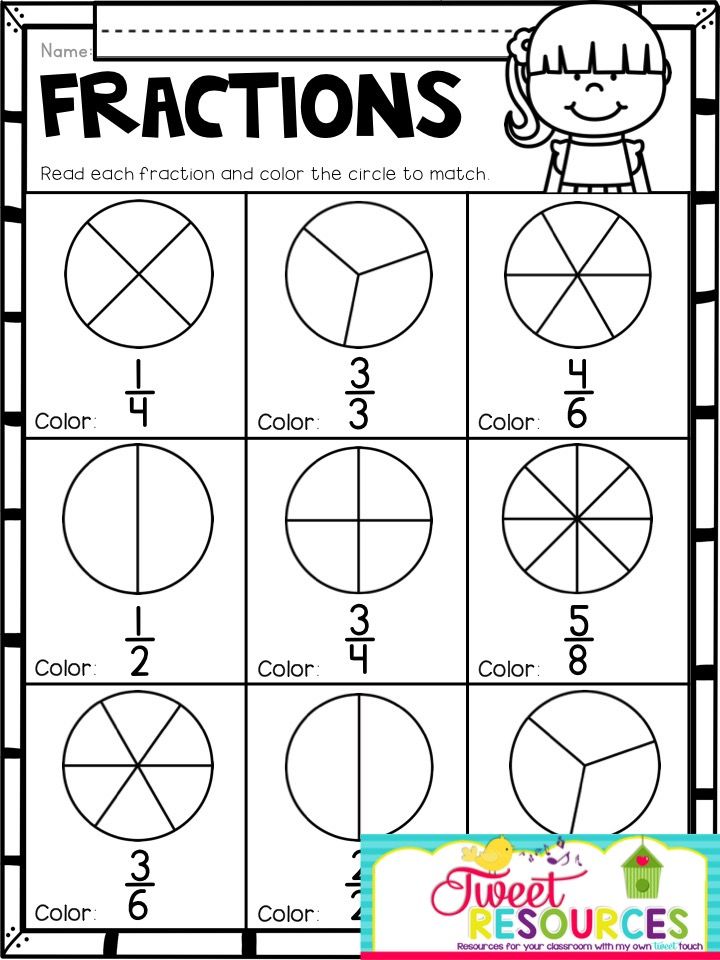 Reduce the fraction 10/25
Reduce the fraction 10/25 Solution. The largest number that both 10 and 25 are divisible by is 5. Therefore, to reduce the fraction, we divide its numerator and denominator by 5:
10/25 = 10:5 / 25:5 = 2/5
A fraction is called in which the numerator and denominator have only one common divisor - one.
Reference:
Reduce the following fractions:
- 6/18,
- 20/40;
- 7/21.
Addition of fractions
First, let's analyze the addition of fractions with the same denominators. In this case, the operation is extremely simple. The numerators of fractions are added, but the denominator remains the same.
Examples:
- 1/7 + 2/7 = 3/7
- 3/8 + 5/8 = 8/8 = 1
Reference:
Add fractions with the same denominators:
But things get more complicated if you need to add fractions with different denominators.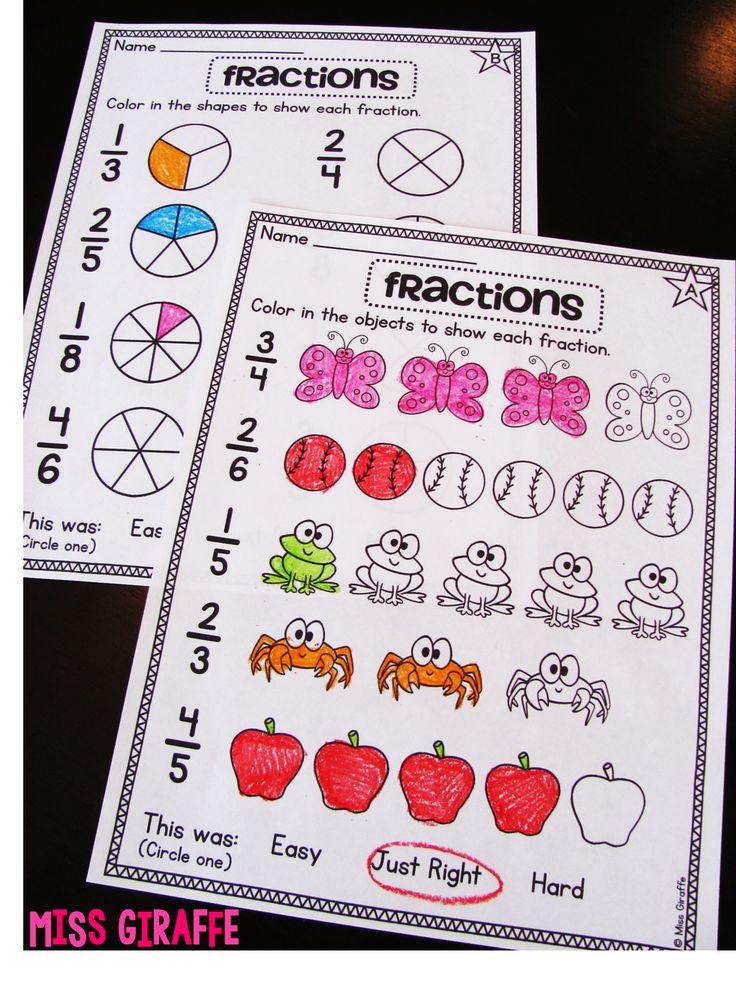 In this case, it is necessary to reduce the fractions to the smallest common denominator. To do this, you need to find the least common multiple. This is a number that is divisible by both of these numbers without a remainder. For example: 3/7 + 2/6 . The least common multiple for numbers 7 and 6 will be 42.
In this case, it is necessary to reduce the fractions to the smallest common denominator. To do this, you need to find the least common multiple. This is a number that is divisible by both of these numbers without a remainder. For example: 3/7 + 2/6 . The least common multiple for numbers 7 and 6 will be 42.
Next, we look for additional factors for each of the fractions. To do this, we divide the least common multiple found at the previous stage in turn by the denominator of each of the fractions:
- 42 / 7 = 6 - this will be an additional factor for 3/7;
- 42 / 6 = 7 is, respectively, an additional factor for 2/6.
Both parts of each of our fractions, both the numerator and the denominator, are multiplied by our own multiplier, defined above:
- 3*6 / 7*6 = 18/42;
- 2*7 / 6*7 = 14/42.
We add the resulting fractions in the same way as the fractions with the same denominators already analyzed above:
- 18/42 + 14/42 = 32/42
If possible, the fraction is reduced.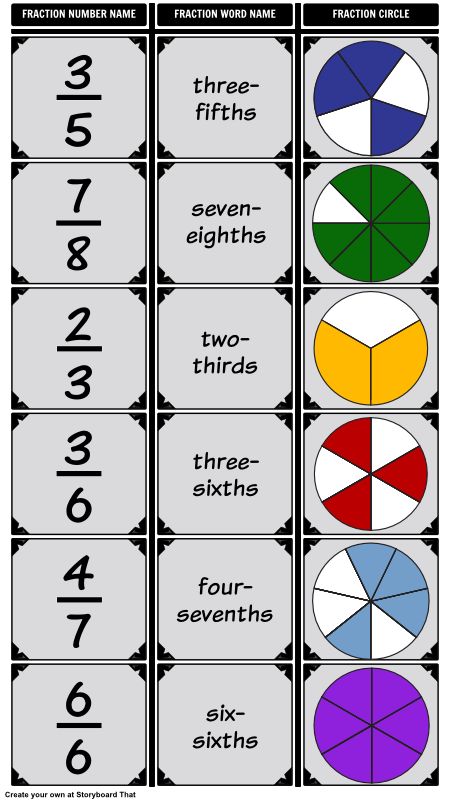 If the fraction turned out to be incorrect, then the whole part should be selected from it.
If the fraction turned out to be incorrect, then the whole part should be selected from it.
Task:
Add fractions with different denominators:
Subtraction of fractions
This operation is carried out similarly to addition. To subtract two fractions with the same denominators, you need to find the difference between their numerators, and leave the denominator the same.
Example:
7/9 - 2/9 = (7-2) / 9 = 5/9
Task:
Subtract fractions with the same denominator:
you also have to find the least common multiple and additional factors. Then, by analogy with addition, subtract.
Example:
6/7 - 8/10 = (6*10-8*7) / 70 = (60-56) / 70 = 4/70
Reference:
Subtract fractions with different denominators:
Multiply fractions
There are two options for multiplying fractions.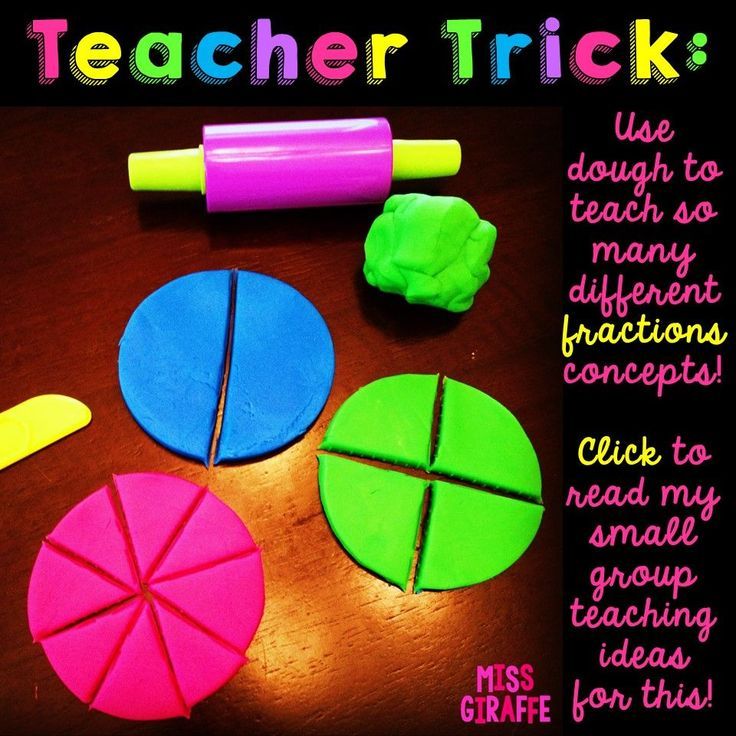 Let's consider each of them in detail.
Let's consider each of them in detail.
Multiplication of ordinary fractions
In this case, the numerators of both fractions are multiplied - this will be a new numerator. The denominators of both fractions are also multiplied - this will be the new denominator.
Example:
2/5 * 3/4 = (2*3) / (5*4) = 6/20 = 3/10
If possible, reduce fractions before multiplying. This will make the next steps easier.
Example:
24/35 * 25/36 = (24*25) / (35*36) = (2*5) / (7*3) = 10/21
Multiplication of mixed fractions
To do this, you need to turn the fractions into improper ones and then follow the algorithm given in the first paragraph.
Example:
4 2/7 * 5 3/5 = 30/7 * 28/5 = (30*28) / (7*5) = (6*4) / (1*1) = 24/1 = 24
Job:
Multiply fractions:
- 5/7 * 6/8;
- 6/11 * 2/3;
- 2 3/7 * 4 5/9;
- 4 6/7 * 7 9/10.
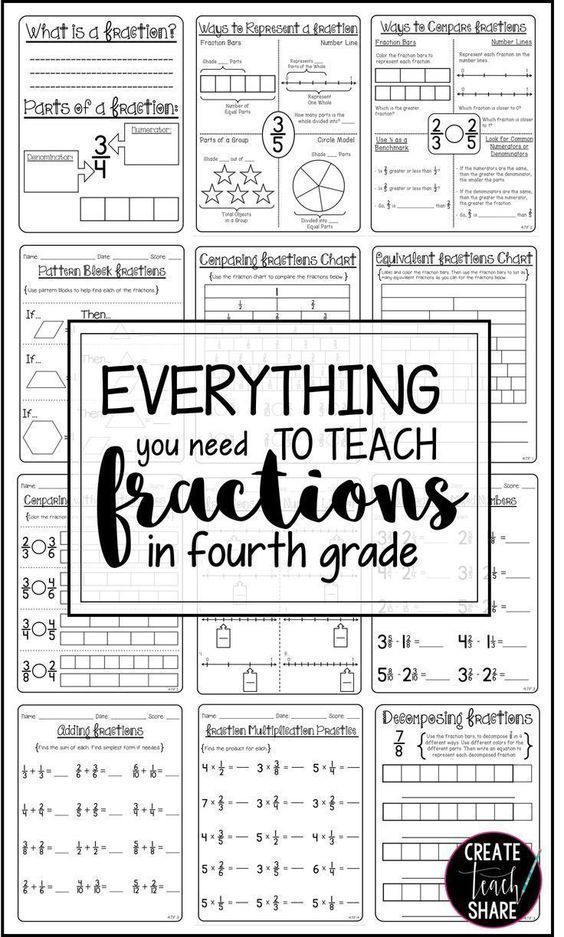
Division of fractions
Having mastered multiplication, division can also be handled easily. The rule for dividing fractions is as follows: when dividing one fraction by another, you need to multiply the first by the reciprocal (inverted) second fraction. Or, in other words, multiply the numerator of the first by the denominator of the second (this will be the new numerator), and multiply the denominator of the first by the numerator of the second (this will be the new denominator).
Example:
4/7 : 2/5 = 4/7 * 5/2 = 20/14 = 10/7 = 1 3/7
There are times when a fraction needs to be divided by an integer. In this case, the fraction should be represented as an improper fraction. Her numerator will be this whole number, and the denominator will be just one. Next, you need to act according to the already familiar rule for dividing fractions from the previous case.
Example:
5/9 : 2 = 5/9 : 2/1 = (5*1) / (9*2) = 5/18
Reference:
Divide fractions:
- 6/11 : 3;
- 7/15 : 2;
- 9/12 : 4.
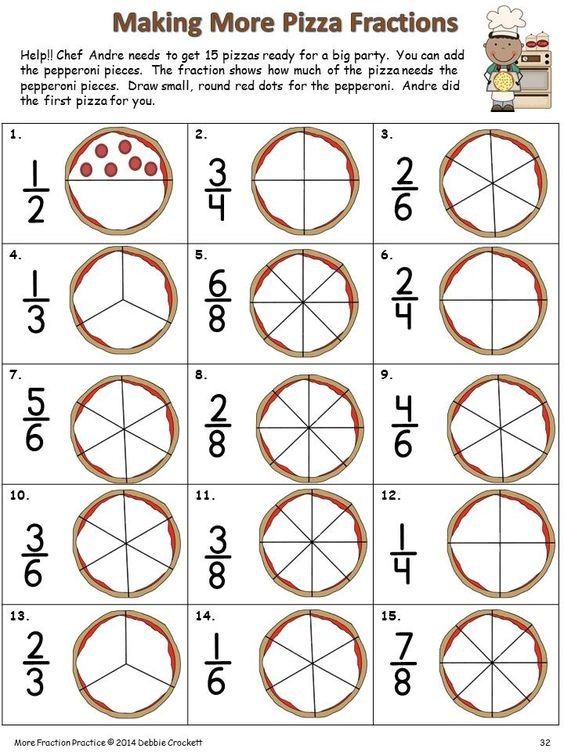
Comparison of fractions
If fractions with the same denominator are compared, it is obvious that the larger one will be the one with the larger numerator.
Example:
1/5 < 4/5 because the denominators are the same and the numerator 1 is less than 5.
Example:
1/2 > 1/8 , since the numerators are the same, but the denominator of 8 is greater than 2.
Fractions with different denominators cannot be compared so easily. You must first determine their common denominator and reduce both fractions to it. The rules for this operation were given above. We get fractions that can be compared very easily.
Example:
Compare fractions 2/5 and 1/10 . To do this, we bring them to a common denominator - 10. We get 4/10 and 1/10 . Now we compare fractions that already have the same denominators: 4/10 > 1/10 .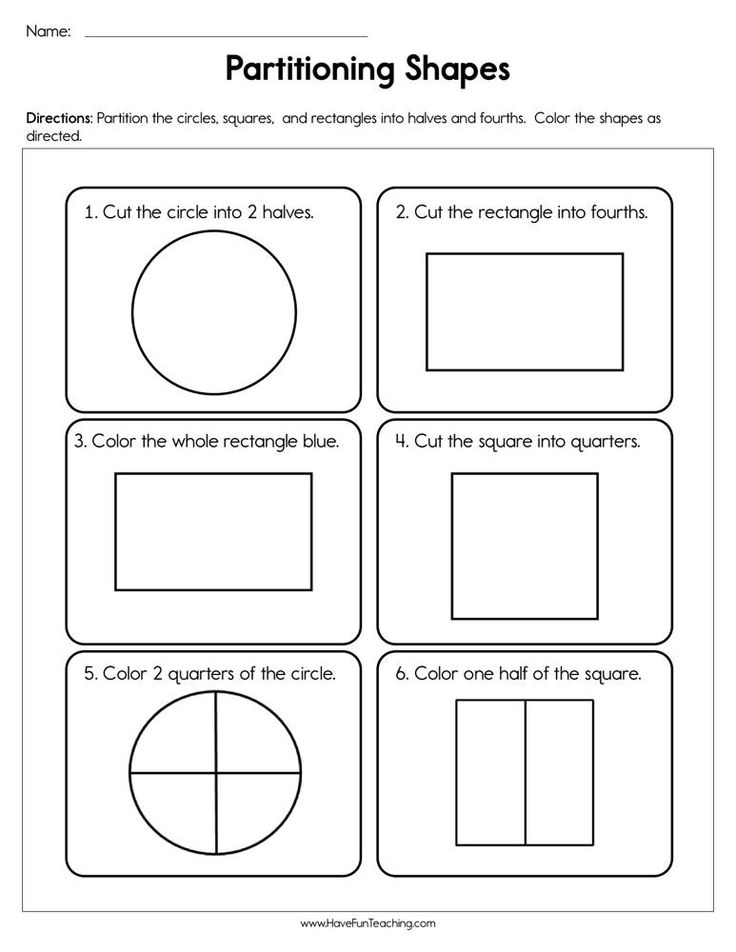
There is one secret to remember. If one of the compared fractions is incorrect, then it is always greater than the correct one. If you think about and remember the properties of fractions, then everything becomes clear. After all, an improper fraction will always be greater than one, while a correct one, on the contrary, will always be less.
Task:
Determine which fractions are shown in the picture and compare them:
So, we have considered fractions, the rules of all actions with them. We hope that our explanations and recommendations will be very useful. Start introducing your kids to fractions before school. Having mastered these concepts well, the child will then easily cope with the recording of fractions and with actions with them.
Mathematics and logic for children 7-13 years old
Developing logical thinking through solving plot mathematical problems in an interactive game format
learn more
See also:
- Multiplication table for children
- How to explain to a child the composition of a number?
Addition of fractions - how to add fractions 🤔
The topic of fractions is one of the most voluminous in mathematics.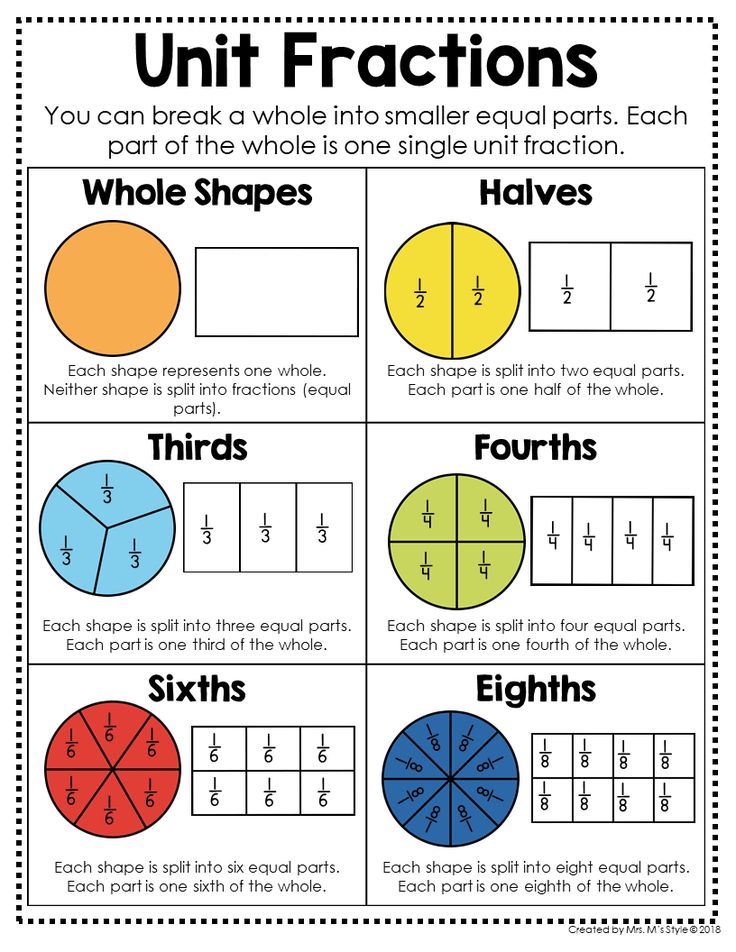 Starting from the fifth grade and until graduation from school, these rules will come in handy again and again. In this article, we will deal with addition. Go!
Starting from the fifth grade and until graduation from school, these rules will come in handy again and again. In this article, we will deal with addition. Go!
The concept of a fraction
The fraction is one of the forms of writing private numbers a and b represented as a/b . There are two recording formats:
- plain - 1/2 or a/b,
- decimal - 0.5.
It is customary to write the dividend above the line, which is the numerator, and below the line there is always a divisor, which is called the denominator. The line between them means division.
There are two types of fractions:
-
Numerical - consist of numbers, for example, 5/9or (1.
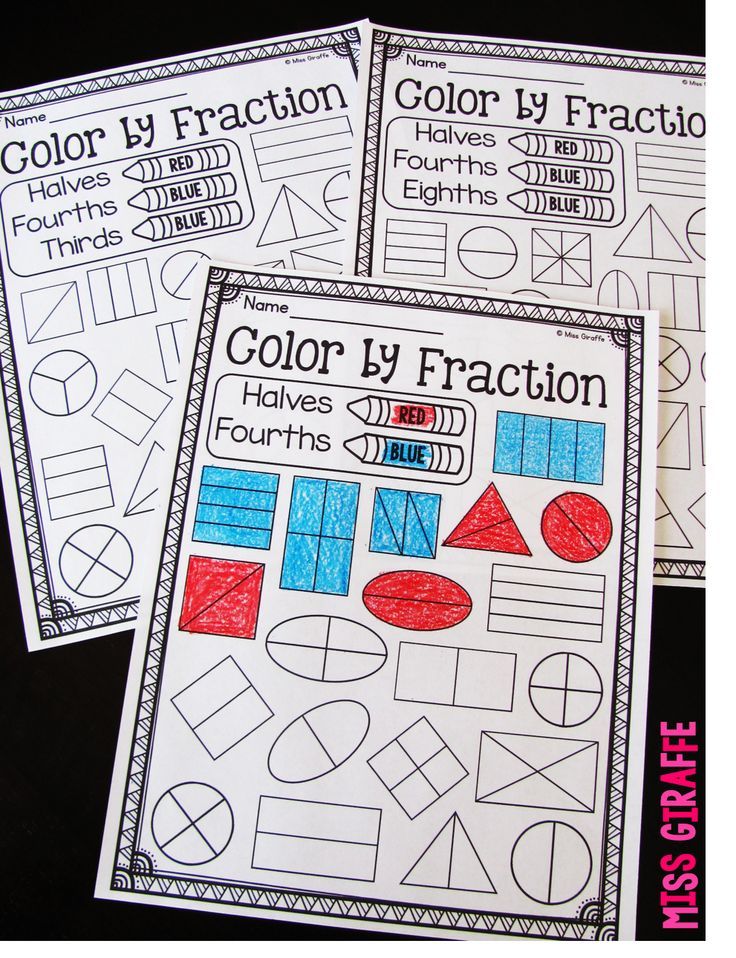 5 − 0.2)/15.
5 − 0.2)/15. -
Algebraic - consist of variables, for example, (x + y)/(x - y). In this case, the value of the fraction depends on the given values of the letters.
A fraction is called proper, when its numerator is less than its denominator. For example, 3/7 and 31/45.
An improper is a fraction whose numerator is greater than or equal to the denominator. For example, 21/4. Such a number is mixed and is read as five point one fourth, and written as 5 1/4.
Demo lesson in mathematics
Find out which topics are “lame” for you, and then analyze them without cramming formulas and boring lectures.
Basic properties of fractions
The fraction has no meaning if the divisor is zero.
A fraction is zero if the numerator is zero and the denominator is non-zero.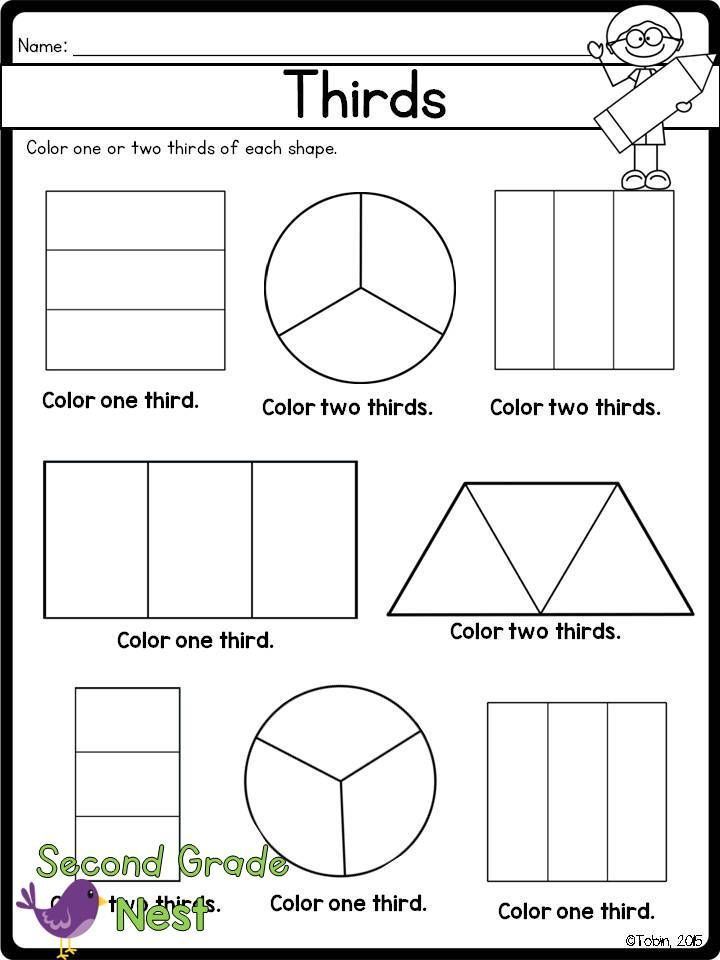
Fractions a/b and c/d are called equal if a × d = b × c.
If the numerator and denominator of a fraction are multiplied or divided by the same natural number, then a fraction equal to it will be obtained.
Skysmart online school invites children and teenagers to math courses for interesting tasks, new applied knowledge and good grades!
How to add fractions
Adding is an arithmetic operation that results in a new number. It contains the sum of the given numbers.
Properties of addition
- The sum does not change from the rearrangement of the places of the terms: a + b = b + a.
- To add the third to the sum of two numbers, you need to add the sum of the second and third numbers to the first number: (a + b) + c = a + (b + c).
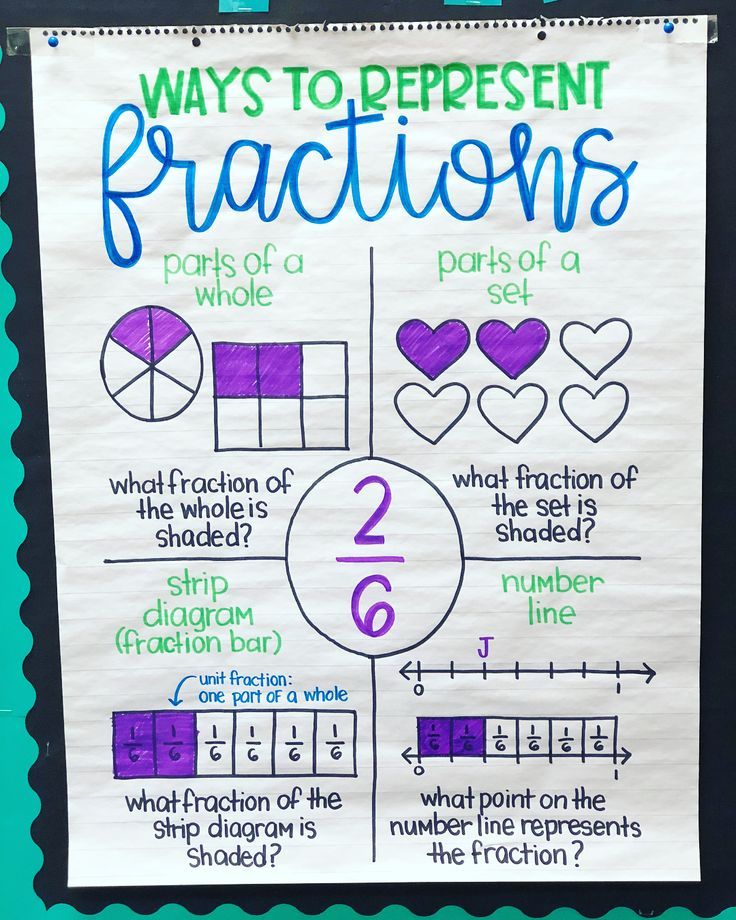
- If you add zero to a number, you get the number itself: a + 0 = 0 + a = a
- When adding numbers, you can rearrange and combine into groups, the result will not change.
Let's look at several options for adding ordinary fractions.
Adding fractions with the same denominators
To get the sum of two fractions with the same denominators, you need to add the numerators of the original fractions, and leave the denominator the same.
Don't forget to check if the fraction can be reduced.
Adding fractions with different denominators
How to add fractions with different denominators - to do this, you need to find the smallest common denominator (hereinafter - LCM), and then use the previous rule. Here's what to do:
1. Find the least common multiple of the denominators (hereinafter - LCM) to determine the common divisor.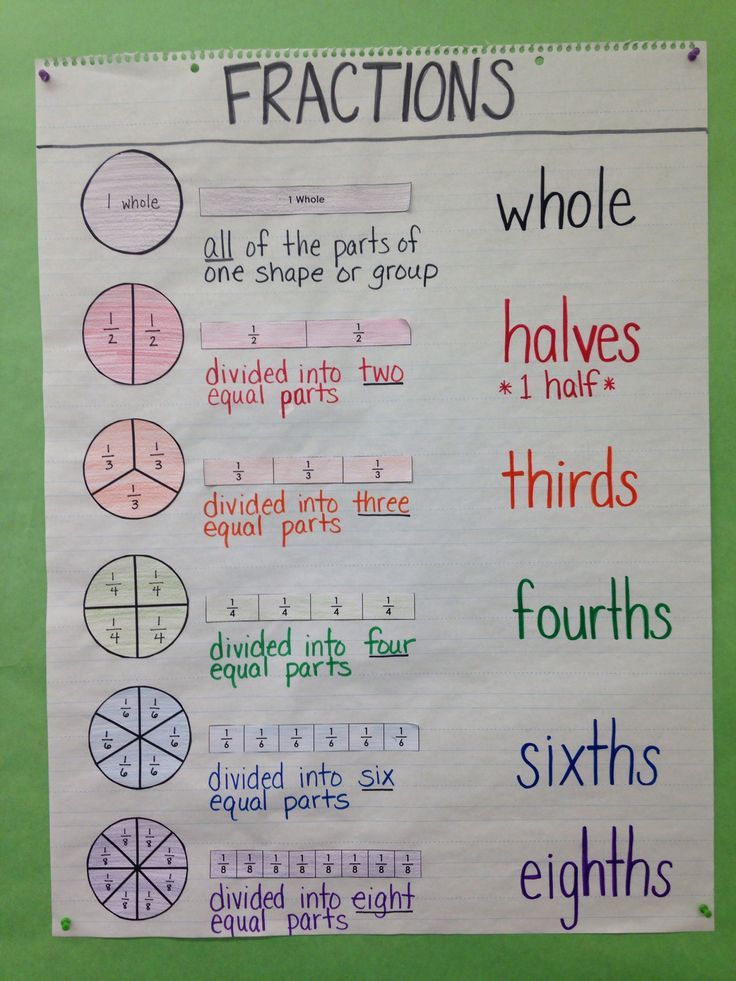
To do this, we write down in a column the numbers that in the product give the values of the denominators of the added fractions. Then we multiply the result and get the LCM.
LCM (15, 18) = 3 × 2 × 3 × 5 = 90
2. Find additional factors for each fraction. To do this, we divide the LCM by each denominator:
- 90: 15 = 6,
- 90 : 18 = 5.
The resulting numbers are written on the right above the numerator.
3. Let's use one of the basic properties of fractions: multiply the dividend and the divisor by an additional factor. After multiplication, the divisor should be equal to the least common multiple that we calculated earlier. Then you can move on to addition.
4. Check the result:
- if the dividend is greater than the divisor, you need to convert it to a mixed number;
- if there is something to cut, you need to cut.
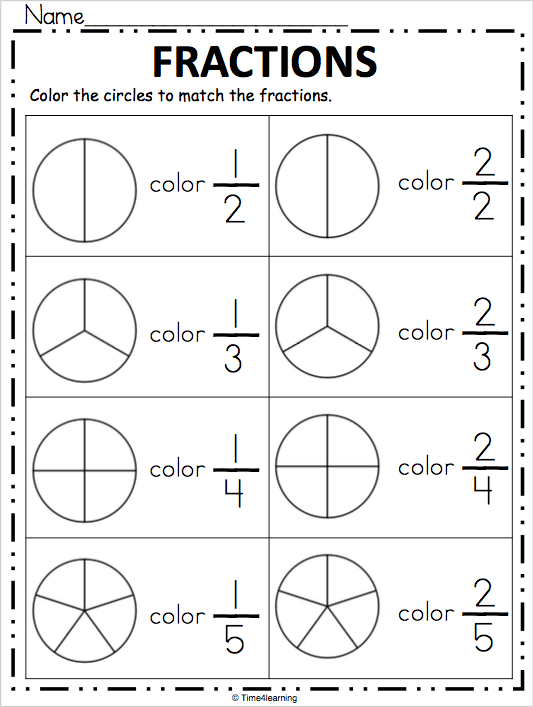
Once again the solution in one line:
Addition of mixed numbers
Addition of mixed numbers can be reduced to separate addition of their integer parts and fractional parts. To do this, proceed in stages:
1. Put together the whole parts.
2. Add fractions.
If the denominators are different, we will use the knowledge from the previous example and bring to the general.
3. Let's summarize the results.
If adding the fractional parts results in an improper fraction, select its integer part and add it to the previously obtained integer part.
Adding and subtracting fractions are related topics: the principles and patterns are very similar. To consolidate your knowledge, practice solving problems for adding fractions as often as possible.